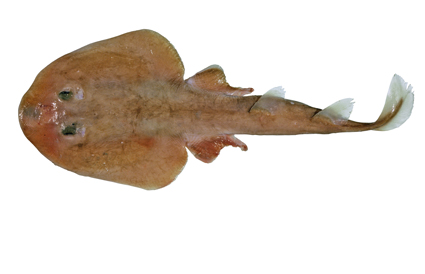Eastern Numbfish , Narcinops nelsoni (Carvalho 2008)

Eastern Numbfish, Narcinops nelsoni. Source: Australian National Fish Collection, CSIRO. License: CC by Attribution-NonCommercial-ShareAlike
Eastern Numbfish , Narcinops nelsoni (Carvalho 2008)
More Info
|
Distribution |
Coral Sea from off Rockhampton to east of Dunk Island, Queensland at depths of 140-540 m. Elsewhere the species may occur in Papua New Guinea. |
|
Features |
Body depressed, shovel-shaped disc reaching its widest point close to the pectoral fin insertion point. Small eyes, about the same size as spiracle; spiracle lacking papillae. Narrow mouth, internasal flap trilobed. Skin surface smooth and creased, no denticles or thorns. Tail relatively long, moderately depressed, gradually tapering. First and second dorsal fin about equal in size, first dorsal fin originating over or just behind rear tip of pelvic fin. Long, narrow pelvic fins. Caudal fin broadly rounded posteriorly. |
|
Size |
Reaches at least 35 cm total length. Sexual maturity for both sexes is reached at 20-25 cm. |
|
Colour |
Dorsal surface generally a uniform light brown, sometimes with a streak of slightly darker brown on dorsal tail surface. Freshly collected specimens present a faint pinkish hue on edges of disc and ventrally on snout region and pelvic fins. Snout sometimes semi-transparent in freshly captured specimens, and generally more tan, lighter than rest of dorsal background color. Dorsal clasper surfaces light tan or off-white, with dorsal clasper glans area sometimes with shades of brown. Dorsal and caudal fins semi-transparent (more obvious in fresh material). Ventral surface is a uniform pale white to cream colour, without distinct markings. |
|
Biology |
Both sexes mature at 20–25 cm TL. |
|
Remarks |
This species was previously known as Narcine nelsoni. |
|
Etymology |
Named after Gareth Jon Nelson, Marcelo Carvalho's PhD advisor at the American Museum of Natural History (New York), "in honor of his very unique and meaningful contributions to both ichthyology and comparative biology in general". |
|
Species Citation |
Narcine nelsoni Carvalho 2008, CSIRO Marine and Atmospheric Research Paper 22: 250, Figs 8-11. Type locality: south of Saumarez Reef, Capricorn Channel, 22°53– 57′ S, 152°59′–153°01′ E, 325–338 m, FRV Soela, S06/85/12. |
|
Author |
Hicks, T. & Bray, D.J. 2022 |
|
Resources |
Eastern Numbfish , Narcinops nelsoni (Carvalho 2008)
References
Carvalho, M.R. de. 1999. A systematic revision of the electric ray genus Narcine Henle, 1834 (Chondrichthyes: Torpediniformes: Narcinidae), and the higher-level relationships of the elasmobranch fishes (Chondrichthyes). Unpubl. PhD thesis. The City University of New York. (as Narcine sp. nov. C)
Carvalho, M.R. de 2008. New species of numbfishes from Australia, with a key to Australian electric rays of the genus Narcine Henle, 1834 (Chondrichthyes: Torpediniformes: Narcinidae). pp. 241-260 in Last, P.R., White, W.T. & Pogonoski, J.J. (eds). Descriptions of new Australian chondrichthyans. CSIRO Marine and Atmospheric Research Paper No. 022: 1-358 See ref online
Carvalho, M.R. de, Compagno, L.J.V. & Last, P.R. 1999. Family Narcinidae. pp. 1433-1446 in Carpenter, K.E. & Niem, V.H. (eds). The Living Marine Resources of the Western Central Pacific. FAO Species Identification Guide for Fisheries Purposes. Rome : FAO Vol. 3 pp. 1397-2068. (as Narcine sp. nov. C)
Carvalho, M.R. de & Last, P.R. 2016. Family Narcinidae pp. 137-169 in Last, P.R., White, W.T., Carvalho, M.R. de, Séret, B., Stehmann, M.F.W. & Naylor, G.J.P. (eds). Rays of the World. Clayton South, Victoria : CSIRO Publishing 790 pp.
Carvalho, M.R. de & Séret, B. 2002. Narcine lasti, a new species of numbfish from western Australia and Indonesia (Chondrichthyes: Torpediniformes: Narcinidae). Records of the Western Australian Museum 20: 393-408 (as Narcine sp. nov. C) See ref online
Last, P.R. & Stevens, J.D. 1994. Sharks and Rays of Australia. Canberra : CSIRO Australia 513 pp. 84 pls. (as Narcine sp. C)
Last, P.R. & Stevens, J.D. 2009. Sharks and Rays of Australia. Collingwood : CSIRO Publishing Australia 2, 550 pp. (as Narcine nelsoni)
Rigby, C. 2015. Narcine nelsoni. The IUCN Red List of Threatened Species 2015: e.T195460A68635060. http://dx.doi.org/10.2305/IUCN.UK.2015-4.RLTS.T195460A68635060.en. Downloaded on 23 January 2018.
Weigmann, S. 2016. Annotated checklist of the living sharks, batoids and chimaeras (Chondrichthyes) of the world, with a focus on biogeographical diversity. Journal of Fish Biology 88(3): 837-1037. (as Narcine nelsoni) https://doi.org/10.1111/jfb.12874
White, W.T., Baje, L., Sabub, B., Appleyard, S.A., Pogonoski, J.J. & Mana, R.R. 2018. Sharks and Rays of Papua New Guinea. Australian Centre for International Agricultural Research (ACIAR) Monograph No. 189. i-vi, 1-327 (as Narcinops cf. nelsoni) See ref online



